Air Colossus | Mil V-12
 •
by
•
by L E V I A T A N

Hello everyone and welcome to Air Colossus this new saga about big metal birds. All of them with something that makes it unique no matter if its new, old or even a prototype.
In this oportunity and following the previous article about the An-225, I want to present you the largest helicopter ever built, the An-225 of the rotorblades, this is the Mil V-12! enjoy!

The Mil V-12 is the largest helicopter ever built. The designation Mi-12 would have been the name if ever produced, but it was never applied to the prototypes.
Design and Development
The Mil Design Bureau started studies for a giant helicopter in 1959, with an official sanction in 1961 by the State Committee on Aircraft Technology (GKAT in russian) instructing Mil to develop a helicopter capable of lifting between 20 and 25 tons. Another directive from the GKAT was given with detailed information about the V-12 which needed to have a dimension similar to the Antonov An-22, this was intended to lift large combat materials for example some models of soviet Inter-Continental Ballistic Missiles (ICBM).

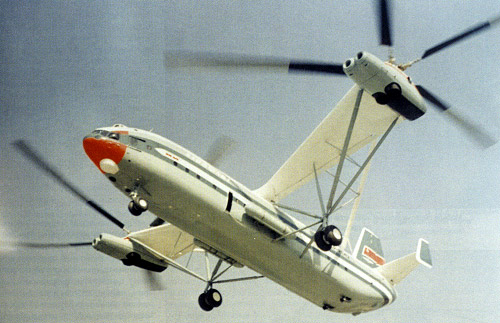
The Mil V-12 prototype in one of its first flights

Limitations in the design forced Mil to adopt a twin rotor system, but studies on a tandem layout (used in helicopters like the Boeing CH-47 Chinook) revealed major problems, leading to adopt a transversal layout for the prototypes.
The transverse system of the V-12 (which eliminates the need for a tail rotor) consists on two Mil Mi-6 transmission systems including the rotors.


The Mil Mi-6 is the V-12 "little" brother, featuring 33 m length.

The construction of the first V-12 prototype, after exhaustive tests including mockups and complete transmissions systems, began at Panki in 1965. The pilot, co-pilot, flight engineer and electrical engineer were located in the lower cockpit, while the navigator and radio operator were in the upper cockpit.
Each power unit comprises two Soloviev D-25VF turbo-shaft engines mounted below main gearboxes, each of them drive five-bladed 35 m diameter rotors. Each paired engine pod has large access panels which open up for maintenance access and also form platforms for servicing crews to operate from.

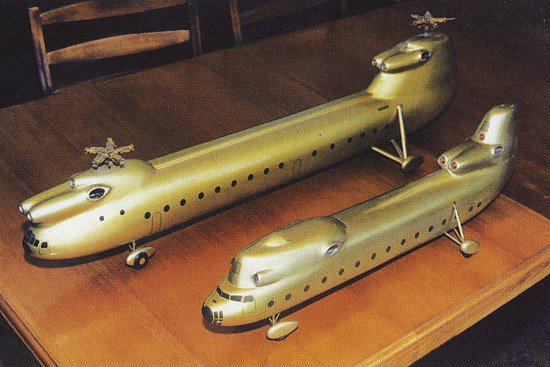
Two Models of the V-12 with tandem layouts

Control of the V-12 presented many problems to the designers and engineers due to the sheer size as well as the rotors layout. The pilot and co-pilot sat in the lower flight deck with a wide expanse of windows to give excellent visibility.
Operational History
The first prototype was completed in 1968. A first flight in June 27, 1967 ended prematurely due to oscillations caused by control problems; one set of the main wheels contacted hard with the ground bursting a tyre and bending a wheel hub. The cause proved to be a harmonic amplification of vibrations in the cockpit floor feeding back into the control column. It was widely but erroneously reported in the Western press that the prototype was destroyed.

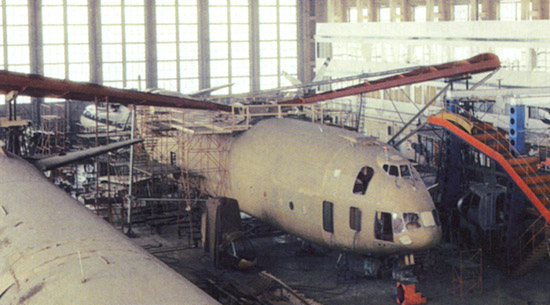
The first prototype being assembled at Panki

The first prototype with the registration SSSR-21142, made its first flight on July 10, 1968 from the Mil factory in Panki, to the Mil test flight facility in Lyubertsy. In February 1969, the first prototype lifted a record 31,030 kg payload to 2,951 m height. On August 1969, the V-12 lifted 44,205 kg to 2,255 m height, also a world record.
The second prototype was also assembled in Panki but sat in the workshop for a year waiting for its engines, flying for the first time in March 1973 from Panki to Lyubertsy. Curiously the second prototype was also registered SSSR-21142.

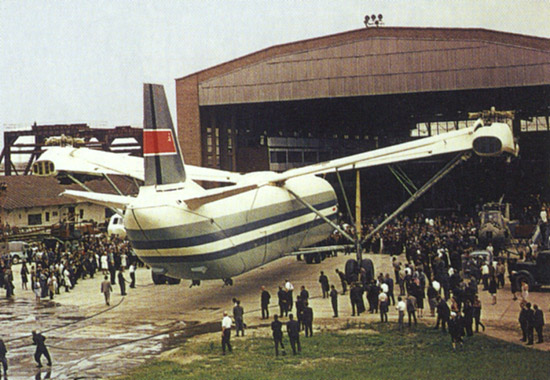
The V-12 in its rollout in 1967

The V-12 prototypes outperformed their design specifications, setting numerous world records which still stand today, and brought its designers numerous awards such as the prestigious Sikorsky Prize awarded by the American Helicopter Society for outstanding achievements in helicopter technology. The V-12 design was patented in USA, Great Britain and other countries.
Despite these achievements the Soviet Air Force refused to accept the helicopter for many reasons, the main one being the V-12's most important mission no longer existed (the rapid deployment of strategic ballistic missiles). This also led to a reduction in the production of the Antonov An-22.

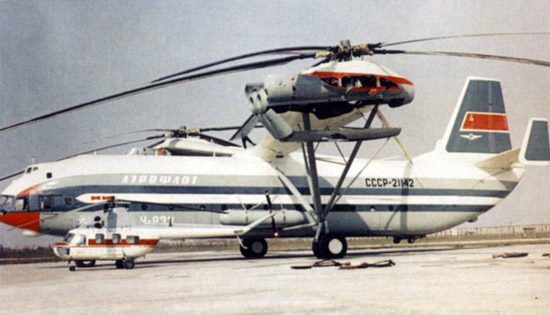
Comparison between the Mil Mi-2 (11m) and the Mil V-12 (37m).

In May-June 1971 the first prototype V-12 SSSR-21142 made flights over Europe including the appearence in the 29th Paris Air Show at Le Bourget wearing the exhibit code H-833.
All developments on the V-12 stopped in 1974. The first prototype remained at the Mil helicopter plant in Panki and is still there today. The second prototype was donated to the Monino Air Force Museum (50 km east of Moscow) for public display.

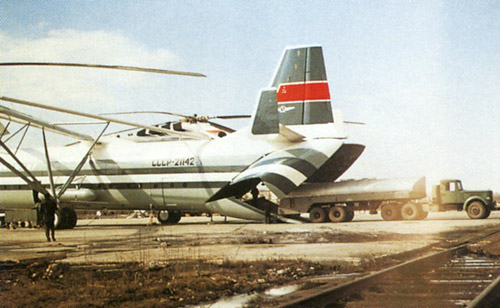
V-12 cargo door opened to receive a truck and its trailer.

Variants
V-12: Designation for the prototypes.
Mil-12: Designation reserved for the expected production version.
V-16: A proposed ultra-heavy version of the V-12, intended to lift 40,000 to 50,000 kg.
Mi-16: Proposed designation for the production version V-16.
Mi-12M: A refined proposed version of the V-16 to transport 20,000 kg over 500km or 40,000 kg over 200km. The M-12M was cancelled at the mock-up stage when the V-12 development programme was cancelled.


Specifications
Crew: 6
Capacity: 196 passengers
Cargo capacity: normal 20,000 kg maximum 40,000 kg
Length: 37 m
Wingspan: 67 m across rotors
Height: 12.5 m
Empty weight: 69,100 kg
Gross weight: 97,000 kg
Max takeoff weight: 105,000 kg
Powerplant: 4 × Soloviev D-25VF turboshaft engines
Main rotor diameter: 2× 35 m
Maximum spee
😛260 km/h
Cruising spee
😛240 km/h
Range: 500 km
Ferry range: 1,000 km with external fuel tanks
Service ceiling: 3,500 m
Photo Gallery








































Well people, this is the moment we all hate
🙁I hope you enjoyed this little bird
😃and don't worry, we will see us again!

If you enjoyed the art, shout it and vote it please!
Air Colossus | Mil V-12
http://www.erepublik.com/en/article/2525824/1/20
V + S!



Comments
First Denied.
Voted!!
Thanks :3
niceeeee
v
Thanks!
There are some nice pics there!
Thank you Bogi :3
o7
o7
Russians like them big 🙂
not so loud or uncle Putin will come 😶
Voted
vruuuuuuuuuuuuuuuuuummmmmmmmmmmmmmmmm
titz an his trademark can't be absent :3
Some strange birds ~(^-^)~
And more are coming! 😃
v 🙂
😘
v
o7
o7
Get to da choppa!!!!
i.imgur.com/ayGSe1A.jpg
RUUUUN, NOOOOOOOW!
NO boobs ,no party !
https://s-media-cache-ak0.pinimg.com/originals/85/70/b9/8570b9b699ae9d8d297907301f8d8365.jpg :3
o7
v
nice article
Thanks buddy :3
Interesante... no lo conocia. Parece un inecto 😛
eee, see, ya se, lo voto y lo endorso. No me retes 😘
Era votarlo noma amiwa, grasia.
eso decis aca, delante de todos... en privado me maltratas y me obligas a endorsarte todo (?
Esa kosa no ce dize amiwa
very good article ! cheers mate !
Thank you! s2
Nice, good airplanes.
o7
Thanks! o7
Global Warming 🙁
U better don't search the post-war USA bombers :3
vrummm
Well done,as always!🙂
Thank you!
interesant , bravo !
Thanks! o7
very nice articles, keep going 🙂
Thanks! o7
Ai dracului rușii ăștia !!!
Păcat că sunt puși mereu pe luat de la alții/
Votaooo chinitooo
Bamoh Naty bamoh!
o/